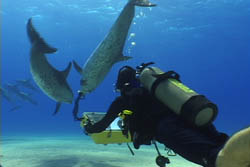

By Hardy Jones, executive director BlueVoice.org
Author soon-to-be released book The Voice of the Dolphins
The Christmas season of 2010 brought a day of reunion for the officers and crew of a cruise ship and the sisters and children of a Catholic orphanage on the Caribbean Island of St. Lucia. In late October Hurricane Tomas had slammed into the island interrupting supplies of water, food and transportation. Some Lt. Lucians had had no food or clean water in days. Noordam came to the rescue.
When hurricanes are bearing down on an island destination, the standard mode of operation for cruise ships is to run for calmer waters so passengers will not be disquieted by the tempest and their safety will be ensured. But when Captain John Scott of Holland America’s ms Noordam learned of the serious destruction caused by hurricane Tomas on St. Lucia he made full speed back to the island he had just departed. Tomas destroyed much of the island’s infrastructure. The lack of drinking water was acute.
The situation was particularly dire at the Holy Family Children’s Home, an orphanage that had been adopted by Noordam and its crew. The kids were hungry, thirsty and scared.
On November 7 Noordam delivered some 50 thousand gallons of water to the main dock in Castries for the general population. This was no easy feat as ships are designed to take on water, not dispense it. But the officers and crew jury-rigged a system to deliver the life sustaining water. They also delivered food from the ships larder and clothing. Passengers chipped in with cash donations that went to the orphanage and an old age home.
I spoke with Captain Scott and hotel manager James Deering aboard the Noordam. “It was nice to be able to help people out when they are down,” the captain told me. And Holland America corporate had been totally behind his aid efforts. The ship was preparing to deliver on the requests for gifts made by the orphans to be delivered a couple weeks later.
After I left the ship James Deering wrote me about the special Christmas visit by Noordam in St. Lucia.
Every child from the orphanage received exactly what he/she had wished for from Santa Claus.
The pool party / brunch went over very well.
The teen girls had their first spa treatments.
The kids ate more than seemed humanly possible - and took the leftovers back home with them.
Our generous guests donated approximately US$1,500 cash, which was given directly to the Sisters who run the orphanage.
We sent boxes of christmas cookies and candies home with them as well to cover Christmas Day.
While on St. Lucia my wife Deborah and I were able to negotiate the washed out roads on the island to take an aerial tram through magnificent rain forest. It was encouraging to see many birds had survived the winds and rain. Some tourist activities were not yet operable but progress is being made in restoration. I have to say St. Lucia is one of the lovliest islands in the West Indies.
I guess I should also mention that I have no affiliation with Holland America Cruise Lines.


